International Expansion of Biodiesel Plants
1.1 Introduction
The research looks into the ways how an overseas biodiesel plant in India and South-East Asia can be expanded on an international scale in order to make them more competitive as compared to the biodiesel plants in the developed and other developing countries. It looks into the prospects of the overseas biodiesel plants in the Indian and South-East Asian markets (Ying et al. 2020). The researchers are of the belief that the Indian and South-East Asian markets are on the rise and have to offer many things to the International market. In this regard, it closely looks into how the overseas biodiesel plants can grow progressively in the Indian and South-East Asian markets.
1.2 Background
Biodiesel has been the obvious choice for many developed and developing countries as an alternative fuel which is renewable in nature and is less polluting as compared to fossil fuels (Coronado et al. 2019). So the biodiesel industry has a huge prospect in terms of growth in the coming days as the most sought after fuel for different purposes.
1.3 Rationale
The markets in India and South-East Asia have been still unexplored in order to assess the growth and progress of the overseas biodiesel plants and the overall biodiesel industry (Thangaraj & Solomon, 2020). However, according to the beliefs of the experts, there is ample opportunity for the growth and expansion of the overseas biodiesel plants as well as the biodiesel industry in the Indian and South-East Asian markets.
1.4 Problem Statement
In order to enter the Indian and South-East Asian market, the overseas biodiesel plant needs to explore a number of factors in order to assess its prospects and growth in the new and unexplored markets of India and South-East Asia (Jiménez-Islas et al. 2020). Most often such overseas plants have limited capabilities in terms of finance, resource, or technological expertise, and so it becomes a prerequisite for such new overseas plants to effectively evaluate the competition in the given market and any time and how it can affect the expansion plans of the business for the overseas plants.
1.5 Main Aim
The main and the foremost aim of the report is to closely analyze the expansion of biodiesel plants on an international scale in the Indian and South-East Asian markets and assess its growth and progress.
1.6 Primary Objectives
The primary objectives of the report are stated as follows:
To identify the viable options for the business expansion of an overseas biodiesel plant in the Indian and South-East Asian markets. To assess the growth measures and opportunities in the Indian and South-East Asian markets for the business expansion of an overseas biodiesel plant. To analyze the microenvironment of an overseas biodiesel diesel plant by implementing techniques of primary research and SWOT framework. To identify the factors pertaining to the external environment of the Indian and South-East Asian markets that affect the business expansion of an overseas biodiesel plant by implementing PESTEL and Porter's Five Forces frameworks. To figure out the best international market entry strategy for an overseas biodiesel plant in order to gain entry into the Indian and South-East Asian markets.
1.7 Relevant Questions
The relevant questions pertaining to the topic of the report are as follows:
Which is the most optimal method in order to expand the business of overseas biodiesel plants in the Indian and South-East Asian markets? Which is the most viable market to expand the business of overseas biodiesel plants in the Indian and South-East Asian markets? What is the best international market entry strategy for an overseas biodiesel plant in order to gain entry into the Indian and South-East Asian markets?
1.8 Significance
The significance of the report lies in the fact that it looks into the prospects of a new overseas biodiesel plant to gain entry into the promising markets of India and South-East Asia. The report shows how the overseas biodiesel plants need to appropriately analyze the markets before it can gain entry into the new and challenging markets of India and South-East Asia (Yusoff et al. 2020). The proper analysis of the market is very much essential for the overseas biodiesel plants in order to understand its opportunities and prospects in the new markets of India and South-East Asia.
1.9 Summary
This particular chapter of the report mainly focuses on how an overseas biodiesel plant can gain entry into the prospective markets of India and South-East Asia. The main aim of the report has also been mentioned in this chapter. The primary objectives of the report have been elaborated in this chapter quite in detail.

Chapter 2: Literature Review
2.1 Introduction
This particular chapter is about evaluating the relevant literature pertaining to the topic of the report. In order to be more specific, this chapter is concerned with exploring the details about the topic of the report and also revolves around the knowledge imparted from the relevant theories and models and the subsequent explanations based on the different works of research based on the topic of the report. This chapter of the report is about the systematic and theoretical assessment of the problem statement as mentioned in the first chapter of the report. This chapter is going through a number of literatures that happens to be covering the different crucial aspects of the topic of the report in order to generate associated hypotheses which are going to play an important role in the later parts of this report. This chapter is going to analyze the different opportunities and prospects of overseas biodiesel plants in the Indian and South-East Asian markets. Moreover, it has also explored on optimal methods in order to expand the business of overseas biodiesel plants in the Indian and South-East Asian markets. Besides this, the chapter also looks into the considerable gap in the different works of literature on the topic of the report and finds ways how such gaps can be filled in the later parts of the report by implementing the appropriate methods of primary as well as secondary research. In this way, a lot of answers to unanswered questions can be obtained which can mark the success of the report.
2.2 Scenario of usage of Biodiesels in India and South-East Asia
According to Elder & Hayashi (2018), the expectations of the Asian countries in the late 2000s suddenly became quite high regarding the production and consumption of Biodiesels on a large scale. It was also believed that it had the potential to increase energy security, reduce greenhouse gas emissions, and provide employment. There were also significantly high expectations of significant trade pertaining to Biodiesels, especially of exports of Biodiesels from South-East Asia to the European Union. Several Asian countries have been producing modest quantities of Biodiesels as they had the privilege of having the Biodiesel mandates.

Presently the quantities of Biodiesels used in the Asian countries have been reasonable, but it is expected to be arduous for Biodiesels in order to meet with the increasing share for the use as a transport fuel. The large scale production of Biodiesels in the South-East Asian countries has not been a realistic approach as it is going to require large-scale diversion of land which in turn is going to increase a considerable pressure on the environment and other essential resources essentially water that is going to be mandatory in the production of Biodiesels. de Hoop (2018), stated that the small-scale production of Biodiesels has always been encouraged in India and in the South-East Asian countries but there has always been a number of challenges in such approaches.
The limited capacity of the farmers, the availability of the essential resources like land, water, labor, and other important inputs had been some of the major challenges in the path of small-scale production of Biodiesels in India and other South-East Asian countries. Sustainability standards along with certification systems have been identified as one of the possible ways in India and South-East Asian countries in order to promote the development of the Biodiesels by giving it a positive momentum. But the sustainable measures have only been a method for increasing the production of Biodiesels but it has never been the solution for enhancing the land cover that can help in large scale production of Biodiesels. According to Coronado et al. (2019), in India and other South-East Asian countries, most of the land cover has already been used or is a forest that has not been productive. Many ecologists are of the opinion that if there is an increasing demand for Biodiesels in India and other South-East Asian countries then there is going to be a shift in the land use which is being presently utilized for food energy crops and which is going to ultimately lead to deforestation. The utilization of agricultural wastes and livestock has been suggested as an alternative source of Biodiesel production in India and other South-East Asian countries, but the collection of these wastes on several occasions has been proved to be not feasible and uneconomical.
2.3 Growth and Opportunities of the business of Biodiesel plants in Indian and South-East Asian markets
According to Sundar et al. (2019), it has been seen to date that the business involving the production of Biodiesels had not been quite lucrative in India and other South-East Asian countries, except few niche markets. But experts think that things can change in the future if there are going to be changed in the prices of fossil fuels, pricing policies laid down by the government, and advancement on the agricultural yields. India has been one of the very few developing countries in the world that have been showing positive development in terms of production of biofuels in the form of biodiesel. Now, this has been possible only due to the far-reaching consensus which has been stating continuously that the production of biodiesel in India can only be promoted if marginal lands are used for growing non-edible oilseeds. Now, this approach has been able to keep the prices of edible oil seeds under check and has been preventing it rising. In India, the development effect of the biodiesel industry has been received with a great response but it generally varies a lot depending on how organized the supply chain has been in the industry. Hamid (2019), stated that the biodiesel industry has been identified as one of the stimulants towards the development and progress of agriculture in India and can be one of the paths for creating employment and source of income for the rural areas. Moreover, it can be fulfilling the country's fuel demand, enhancing energy security, and moreover saving a lot on foreign exchange. According to Rezania et al. (2020), the demand for bioethanol and biodiesel in the South-East Asian countries had generally been met by their domestic and regional markets as well as it had been exported to other Asian and European countries. In a study, it has been revealed that Thailand has been playing a pivotal role in the consumption and export of bioethanol in that region. The study also revealed that among the South-East Asian countries Malaysia and Indonesia have been the key players in the export of biodiesel, and on the other hand the study also reveals that due to high domestic demands in the Philippines had resulted in its import dependency on bioethanol.

The renewed interest in alternative sources of fuel has been the main driving force for the promotion of the usage of biofuels in the South-East Asian countries besides minimizing the dependence on imported oil and climatic change mitigations. Moreover, biofuels have been boosting the economy of the South-East Asian countries through new market systems and higher disposition income for the feedstock producers and the other market chain operators (Hamid, 2019). The increasing dependence on biofuels has also been a major factor in reducing the emissions of harmful greenhouse gases in South-East Asian countries.
2.4 Optimal methods to expand the business of Biodiesel plants in Indian and South-East Asian markets
According to Mayasari et al. (2019), the energy demands have been increasing exponentially with an increase in the population in the South-East Asian countries, and meeting the rising energy demands through the increasing consumption of fossil fuels has only resulted in increased emission of greenhouse gases and has also been endangering the energy security of the South-East Asian countries. This has been also a cause of increased pressure on the importers and exporters. The energy security concerns have been rising as the stocks of indigenous fossil fuels are being constantly depleting and so most of the South-East Asian countries are constantly facing the challenges to meet the increasing energy demands. In order to meet this challenge, the search for the diversified energy mix has been the sole purpose of many South-East Asian countries. So in order to achieve diversification of energy supply, appropriate investments in renewable sources of energy, integrated with advancements in energy efficiency have been recognized as one of the most viable options for the business of Biodiesel plants to expand smoothly and seamlessly in the Indian and the South-East Asian countries. This approach has also been assuring the business of Biodiesel plants with substantial benefits in the socio-economic and environmental grounds. The potential of renewable sources of energy offering substantial opportunities by providing cost-effective energy supply to the South-East Asian countries has also been a promising aspect for the Biodiesel plants to expand in the Indian and South-East Asian markets. The energy transition from the use of non-renewable sources of energy to renewable sources of energy has been aiding in the regional growth of the South-East Asian countries including India. Bourcet (2020), opined that the substantial deployment of renewable energy has been showing a very small impact on the GDP of the South-East Asian countries, but the impact has been positive which has renewed the confidence and interests of the businesses involving the Biodiesel plants to make considerable investments in order to expand in the Indian and the South-East Asian markets. The South-East Asian markets are becoming truly interesting and promising for the businesses involving the Biodiesel plants as the use of biofuels has been steadily growing and it has become evident from the fact that Indonesia, the Philippines Malaysia, and Thailand have been the major markets for biofuel in South-East Asia.
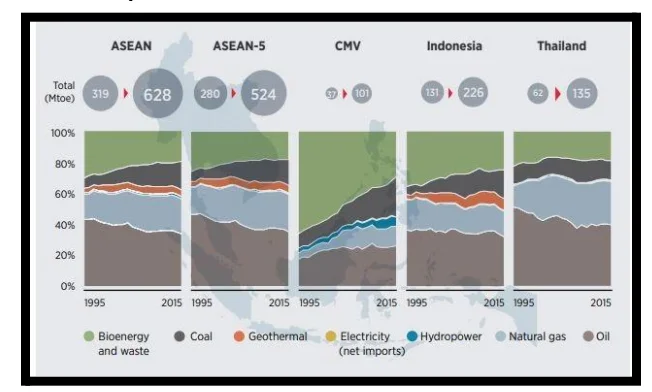
According to Taghizadeh-Hesary & Taghizadeh-Hesary (2020), as most countries in South-East Asia has been setting renewable energy targets and had approved some new policies concerning national renewable energy in order to meet these targets, it has opened the doors of opportunities and prospects for the businesses involving the Biodiesel plants to make an impact by expanding in the markets of South-East Asia including India.
2.5 Competition in the business of Biodiesel plants in Indian and South-East Asian markets
According to Ahmed (2020), the competition in the business of biodiesel plans has been increasing with time as more developing and developed countries in South-East Asia are turning their focus to embrace greener and cleaner sources of energy. The prevalent dependence on fossils fuels had been a major reason threatening the energy security of many developing and developed countries in South-East Asia and also a major source of emissions of greenhouse gases which had led to environmental impacts like global warming. In this respect, most of the developed countries and developing countries in South-East Asia are bringing about changes in the policies concerning energy consumption and adopting renewable sources of energy in order to protect the environment, the businesses of biodiesel plants had been spending hectic time in finding ways to infiltrate the Indian and South-East Asian markets. They had been busy devising strategies in order to launch their products in the Indian and South-East Asian markets which had been drawing the attention of one and many. Nyström et al. (2019), opined many companies dealing with businesses in biodiesel plants have been focusing on the markets in India and South-East Asia as they had been always promising as well as lucrative and had never left the new businesses down. So many companies with renewed interests had been trying to infiltrate the markets and that had led to increased competition between them. These companies had been changing their strategies every now and then in order to get a competitive advantage they require to grow and progress in the Indian and the South-East Asian markets. Many South-East Asian countries offering sanctions and subsidies to the overseas biodiesel plants have been another contributing factor towards the increasing competition between the companies to gain entry and run their business in the Indian and South-East Asian markets. But such government subsidies and sanctions are often offered to a limited extent due to the financial constraints of the government. However, some other measures like tax exemptions offered by countries like Thailand to the companies dealing with businesses in biodiesel plants have been promoting healthy competition between the various biodiesel companies.
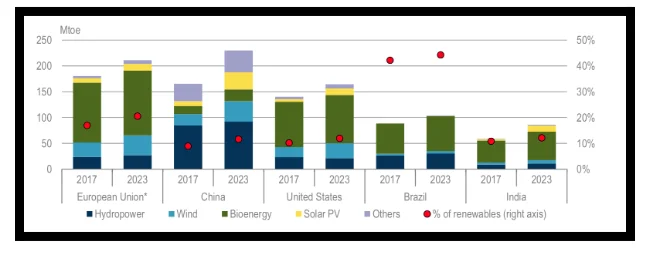
According to Lama (2020), foreign investment has been encouraging the business involving biodiesel plants to build advanced frameworks and utilize technological innovations in order to expand their business in the Indian and South-East Asian markets and gain a competitive advantage over the other companies. Again foreign collaborations in the business involving biodiesel plants have been bringing a new revolution in the industry and have been quite promising for the companies. For example, in India, the collaboration between the Indian Oil Company with the US National Renewable Energy Laboratory had given a new dimension to the development and growth of biodiesel plants in India.
2.6 Literature Gap
This particular chapter has gone through a number of scholarly journals, articles, and publications which are mostly based on the topic of the report. The rich source of information and knowledge that has been collected from these sources has indeed given this report a new dimension. In this review of the literature at one point, it has been highlighted by an author that the growth of the biodiesel industry has been creating employment and source of income in rural India (Hamid, 2019). However, in order to support this fact, there has been no concrete evidence provided by the author. This can be regarded as one of the gap in the literature which has been noticed in this chapter and so it has been highlighted in this literature gap. On the other hand, the review of literature an author points out the deployment of renewable sources of energy has a mere impact on the GDP of a nation (Bourcet, 2020). The author has given his opinion about this fact but the author has been unable to provide any proper justification in order to support the statement. This is again regarded as one the gap in the literature that has been referred in order to prepare this report. And so this has also been highlighted in this section as a literature gap. Such a gap in literature helps to give a new direction as well as motivation in order to explore to find any answers to the gaps in the literature.
2.7 Conceptual Framework

2.8 Summary
This chapter has given a detailed understanding of how overseas biodiesel plants have been looking for options to gain entry in the Indian and the South-East Asian markets and expand their business. The present scenario about the usage patterns of biodiesel in the Indian and South-East Asian markets has been analyzed in this chapter, in order to understand how biodiesel has been accepted in these regions. In other words, it had closely evaluated how the increasing dependence on alternative sources of fuel has been a source of motivation and inspiration for the overseas biodiesel plants in order to expand their business progressively and systematically. The chapter also depicts how there lie ample opportunities for the biodiesel industry to gain entry in the Indian and South-East Asian markets as these markets have several prospects that can be easily tapped by these companies. Moreover, it also highlights on how to increase opportunities in the Indian and South-East Asian markets has also increased the competition between the companies to offer the best to the consumers. The gaps in the different works of literature on the topic of the report has also been highlighted in this chapter which can be a source of developing propositions that can help in the primary research in the subsequent parts of the report.
Chapter 3 Research methodology
3.1 Introduction
Research methodology refers to the procedures and strategies used in order to recognize, define and analyze the data collected for the topic. According to Kothari (2004), the section of research methodology provides knowledge about the evaluation of the data that is available from different sources and also helps in considering the validity and the reliability of the gathered information. The chapter chiefly deals with the topic of gathering information, the technique or methods used, the instruments required for the process and the analysis of the gathered data that will help the reader to understand the research subject and illustrates the reason for the choice.
3.2 Research philosophy
Research philosophy is the hypothesis of the ways used to garter the data and analyze it in order to use it for the research purpose. Research philosophy can also be defined as the method that deals with the source, quality and the expansion of the gathered data. As stated by Holden & Lynch (2004), research philosophy is the manifestation of how data would be collected, examined and utilized. For this paper, the research philosophy adopted in order to understand the biofuel market in India and the Southeast Asian market. The research philosophy, as stated by Mkansi & Acheampong (2012), constitutes of three types of beliefs, namely, realism, positivism, and interpretive. Realism deals with the truth of information sources, interpretive deals with the difference between the researches carried out between humans and machines and positivism deals with the scientific approach towards the data that provides reasonable observations. The revised version of the positivism philosophy is termed as post-positivism.
3.3 Research Approach
The philosophy used for the research paper is positivism interpretive philosophy as the data that is collected will be evaluated in a scientific manner and the result of the analysis will be adequate. As stated by Marton (1986) the research has been conducted on the basis of validities of the situations at overseas biofuels business, therefore the positivism philosophy will be the most suitable. The data collected will be based on generic concerns, along with the working if the business, the employee's safety. On the other hand, the realism philosophy has but been chosen as the data collected will be analyzed through scientific methods and calculations. There will be some analysis on the basis of the social factors and the concise. As stated by Barnard, McCosker & Gerber (1999), the positivism philosophy will help go understand the comprehensive issues faced by the business, especially for the overseas expansion and how they can solve and will help to recognize the subjective calculation.
3.4 Research Design
Research refers to the complete procedure chosen in order to put together all the elements of the research in a coherent and reasonable manner that will ensure the effective outcomes of the reach carried out. As opined by Maxwell, (2012), a research design should be able to identify the issues, explain the theory, and describe the data required and the methods used to analyze them. The key factors of a research design are neutrality, reliability, validity and generalization. According to Wang (2015), neutrality refers to the researcher analyzing the data without any preference whereas; reliability refers to the results being satisfactory to the research. Research design can be differentiated as descriptive research, experimental research, correlation research, diagnostic research and explanatory research. According to Kuehl & Kuehl (2000), descriptive design refers to describing the situation or case of the research topic, whereas experimental design refers to the factors and impacts related to the research topic. Correlation design refers to the relation between two similar research topics, on the other hand, the diagnostic design is defined as an evaluation of the underlying cause if the research whereas explanatory refers to the researcher's ideas and thoughts on the research topic.
3.5 Research Strategy
The research strategy is a step by step plan that helps the researcher to implement and monitor the research process. As opined by Benbasat, Goldstein & Mead (1987), research strategy provides a direction to the ideas and the required efforts in order to conduct the research efficiently and thorough results. It helped to keep the focus, improve the quality and most significantly saves the time and resources required to complete the research. Zednik &Jäkel (2016), opined that, Case study refers to the examination of a single case to the dept, whereas the action-oriented refers to the practical exploration of a business in order to implement changes or recommendations. On the other hand, qualitative interviews may be structured, semi-structured or unstructured questions used to gather information via individuals or groups whereas quantitative surveys help to catch up with a huge number of participants, and are conducted through online sites with the help of questionnaires.
3.6 Research Technique
In Order to conduct research, techniques have required that help to gather and analyze the data to provide the required results. According to Thomson (2018), the quantitative analysis refers to the collection and analysis of the data, primarily in numerical form and includes data collection tools as questionnaires. For this research, both the techniques, quantitative and qualitative analysis has been used in order to get the required outcome. For quantitative analysis, the Likert scale is used to form the questionnaires and accumulate the required information and process is accomplished by online portals. For quantitative analysis, employees have been interviewed face to face and their views are noted.
3.7 Reliability and Validity
Reliability and validity are the notions that help to compute the quality of the research. Both need to demonstrate how a procedure, method and technique have been effective in order to provide the required result. Reliability helps to understand to what extent the outcomes can be reflected in future research for related topics whereas validity helps to measure the outcomes. As opined by Mohajan (2017), reliability is examined by monitoring the results over time and observers whereas validity is assessed by monitoring the results with comprising theories about the research topic. For the paper, the quantitative analysis has helped in identifying valid information to the research and qualitative analysis will provide reliable data for the research.
3.8 Limitations
There have always been limitations, and the researcher should find ways to minimize the limitations in order to conduct effective research. As stated by Queirós, Faria & Almeida (2017), the limitation of research should be observed and recognized ahead in order to have a complete understanding of the research. Limitations can prevail because of the implementation methods, the lack of studies, and formulation of the objectives. For the paper, the limitation that has been observed is the limited area for conducting the survey.
Chapter 4: Data Analysis
4.1 Introduction
Data analysis is defined as the process of inspection, rearrangement and modification of the collected information in order to extract the required insight along with analysing in an ethical manner. The essential components of data analysis are data organization, summarization and categorization that help the researcher to find the relation and links in the gathered information (Watkins, 2017). For the paper, the methods used for the analysis of data are thematic and subjective analysis.
4.2 Quantitative Data Analysis
Quantitative data analysis refers to the methods procedures that emphasizes on the quantities, statistical, mathematical or numerical data analysis of the data gathered by surveys, polls, questionnaires or the evaluation of the last records (Mertens, Pugliese & Recker 2017). For the paper, the method used for the quantitative analysis is a questionnaire that consists of closed ends questions, some personal and others related to the research topic.
Section 2: Close Ended (Expansion)
(1 = strongly disagree 2 = don’t agree 3 = Agree 4 = strongly agree 5 = I don't know)
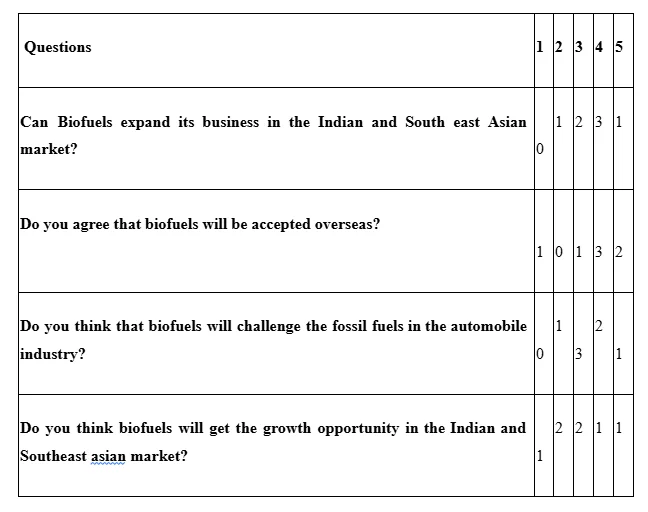
Section 3 : Closed End(Environment Analysis)
(1 = strongly disagree 2 = don’t agree 3 = Agree 4 = strongly agree 5 = I don't know)
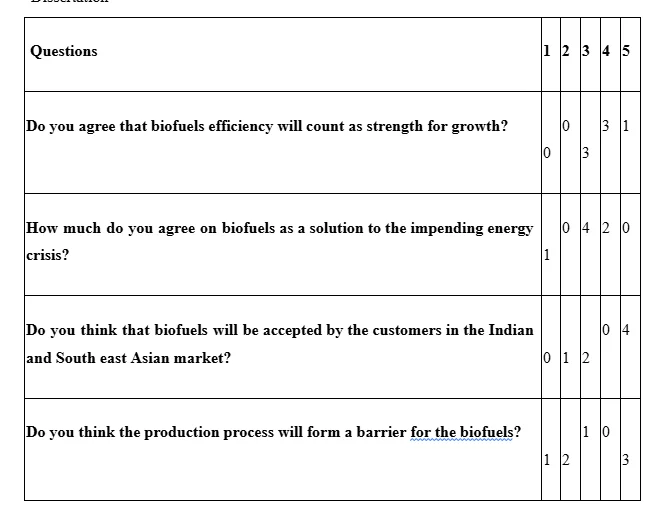
Analysis
Section 1: Closed Ended (Personal)


Findings
The information collected shows that the respondents are nearly equal from both genders. Males consisting of approximately 58% whereas females being 42% of the total respondents


Findings
The graph provides affirmation that maximum respondents are from the age group of 25 to 35 years.

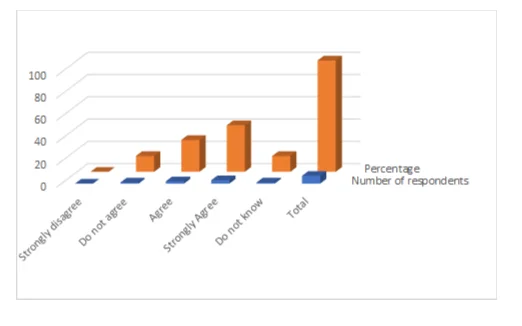
Findings and Analysis
From the survey, it is recognised that the majority agree with the expansion of the biofuel industry in the Indian and the South Asian market. This agreement is recognized, as Strength for the expansion in accordance with the SWOT analysis.


Findings and Analysis
The information gathered signifies that the majority have agreement about the acceptance of biofuels overseas, which will result as strength for the industry in the global market as per the SWOT analysis.
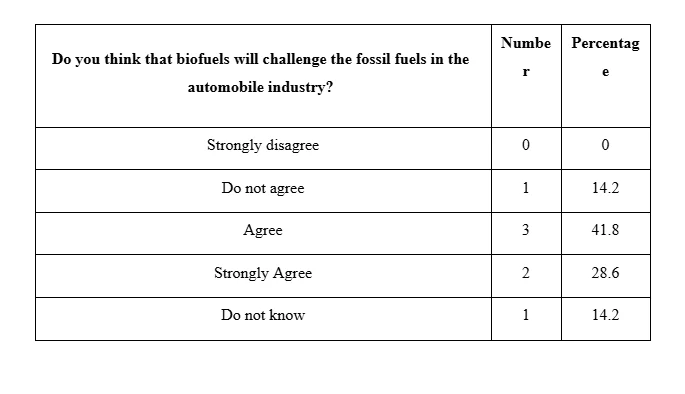

Findings and Analysis
Considering the information from the survey on biofuel challenging fossil fuels, it is interpreted that most think biofuel will be able to compete with fossil fuels in order to run the automobile industry. This can be perceived as an Opportunity for the biofuel industry in the market according to the SWOT analysis.


Finding and Analysis
Analyzing the data received from the survey about the opportunities of the biofuel industry in the market, it is recognized that people have mixed reviews, owing to lack of clarity about the product. This survey has helped in recognizing the weakness according to the SWOT analysis, and the industry needs to provide customers sufficient information about biofuels.
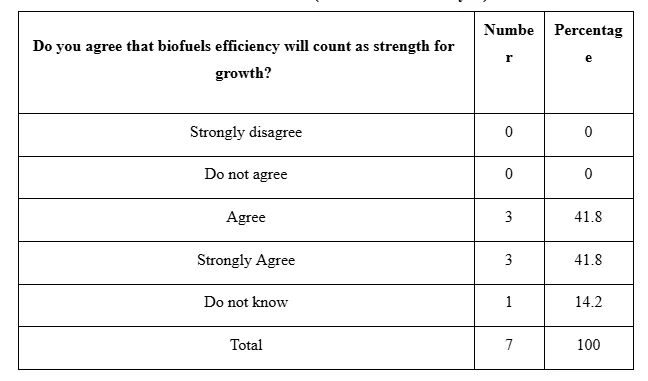

Finding and Analysis
With the gathered information it has been analyzed that most of the respondents support the efficiency aspect of biofuel, which can be considered as an opportunity and strength according to the SWOT analysis in the growth of the industry.


Finding and Analysis
Evaluating the data from the survey, it has been noticed that the majority agree to biofuel being a solution to the energy crisis, contributing as an opportunity for the industry in the Indian and South East Asian market.

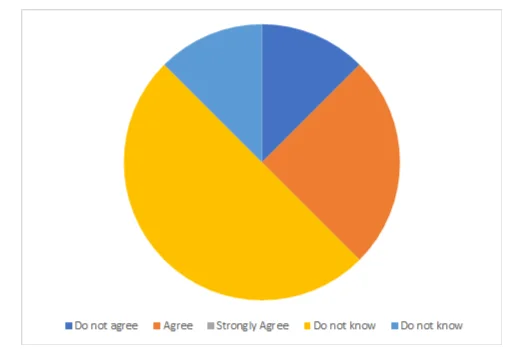
Finding and Analysis
Analysis of the data from the survey reflects that many are not sure about using biofuel, which can be considered as a threat for the biofuel industry, especially for overseas markets.
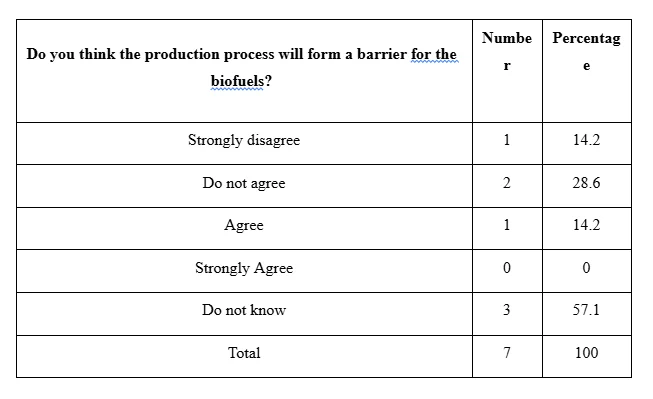

Finding and Analysis
On evaluation of the information from the survey, it is noticed that the majority consider the production process as a barrier, which contributes as a threat for the biofuel industry in order to establish in Indian and Southeast Asian markets.
4.3 Qualitative Data Analysis
Qualitative analysis refers to data received through interviews and depends on the researcher's analytics and interacting skills. The questions with responses are provided.
Q 1. Are the factors of the Indian and south-east Asian markets suitable for the expansion of the biofuel business?
The question was asked to two managers and their responses are as follows.
According to the first manager, the increasing number of vehicles with increasing fuel prices will provide an opportunity for biofuels. As biofuels are cheaper, renewable, and environmentally friendly, and the countries are developing, will be a good market for biofuels that will benefit both the business and the nations. As for the second manager, the cheap price and the reliability of the biofuels will help the nations maintain their ecological balance and help in sustainable development along with helping to deal with the depleting non-renewable sources of energy along with improving the economy as the production cost is lesser when compared to fossil fuels.
Q 2. Do you consider any elements that can affect the expansion of the business?
The question has been asked to two managers and their responses are as follows
For the first manager, the political factors and the legal formalities might pose as a barrier in the expansion. Owing to different political scenarios between the Indian and the Southeast Asian countries the company needs to plan accordingly in order to explain the advantages. Considering the opinion of the second manager, the economic situations in the south-east Asian countries need to be overcome and the company should be able to show the benefits of biofuels for the county in improving the economy and along with the environmental conditions.
Q.3 Suggest any strategy suitable according to you that will help the expansion.
The concern was put forward to two managers and their thoughts are as follows. According to the first managers, the organization should put forth the benefits of biofuels, make the citizens understand the efficiency by conducting workshops and asking people to be part. Along with this, the company should be able to convince the government about the advantages of biofuels, how it will help the environmental sustainability and help in economic development. As for the second manager, the business will benefit mostly the population, so the advantages of biofuels over fossil fuels should be explained to all and the awareness should be spread by various means, through advertisements, via social media, and more. The support of the public would be an excellent way to grab the market as they will be their customers.
Discussion
The fundamental information has been analyzed and collected from questionnaire surveys and interviews. The survey was conducted among seven employees and interviewed by two managers. The gender dominance was nearly equal fit the survey surveys, consisting most from the age group of 25 to 35. The majority wants the expansion of the biofuel industry in the Indian and south-east Asian markets, and they think biofuels will be accepted fully in the markets. Owing to the depleting fossil fuels and increased price and increased vehicles, the biofuel industry will get an opportunity to grow and be a solution for the energy crisis.
Summary
From the analysis of the responses from two managers considering the factors for expansion, and affecting the expansion along with their suggestions for strategies, considering the pestle and porter five force theory, the outcomes are as follows. The organization needs to understand the political scenario of different countries in order to implement the required plans accordingly. Moreover considering the energy crisis, the biofuel industry will get a great opportunity to expand their businesses overseas and especially in the India and Southeast Nissan markets. According to the analysis, with the pestle framework, the political and economic situations can be a complication in the expansion that can be overcome with the right awareness. On the other hand, spreading the knowledge about the production process, efficiency of biofuels over fossil fuels will help the industry achieve a great enhancement in acceptance from the customers across the overseas markets.
Chapter 5: Conclusion and Recommendations.
5.1 Conclusion
In consideration of all the highlights and the factors that can affect the expansion of the biofuels industry in the Indian and the South East Asian markets, the advantages are well perceived. Therefore, in this section of the paper, the valid points in accordance with the research are concluded. After analyzing the collected information, the data figures, and facts, it can be concluded that the overseas expansion of the biofuel industry will be beneficial for the business and the markets. This chapter helps in recognizing the significant factors and measure that the industry should undertake in order to overcome the hurdles in the international expansion of the businesses. The Indian and the south-east Asian markets would provide the industry with great business opportunities owing to its environmental issues and increasing automobiles. In the introduction chapter, the objectives if the research has been illustrated, the second chapter focused on the previous literature on the topic, the third chapter evaluated the research methods whereas the fourth chapter deals with the information and data collection and analysis. This chapter forms the fifth and final chapter of the paper and the relevant details and recommendations are referred to in it.
5.2 Link with objectives
Objective 1: Identification of the viable option for overseas expansion of the biofuel plant in the Indian and south-east Asian market
According to the data collected and analyzed, the researcher has been able to connect the overseas expansion objective in the markets. The factors of India and South East Asia countries, has been supported through the questionnaire survey and question one of the qualitative analysis.
Objective 2: Analyzing the growth factors and opportunities in the Indian and Southeast Asian markets.
This objective can be connected with the second chapter of the research paper, as it explains the scenario of biofuel usage in India and South East Asia and from the analysis of the data accumulated through the survey, the opportunities have been recognized.
Objective 3: Analyzing the microenvironment of an overseas biodiesel diesel plant by implementing techniques of primary research and SWOT framework.
The survey data is liked with the given objective, as the factors supporting the expansion are recognized as strength, the lack of awareness as a weakness, the competition as a threat, and the depleting non-renewable energy as an opportunity to.
Objective 4: Identification of the factors pertaining to the external environment of the Indian and South-East Asian markets that affect the business expansion of an overseas biodiesel plant by implementing PESTEL and Porter’s Five Forces frameworks.
The political and economic factors that can be considered as an obstacle are linked with the qualitative analysis. The environmental factors are in support of expansion hence the given objective can be linked with the interview questions and concerns that the situations of economic conditions are responsible behind Biodiesel Plant.
Objective 5: To figure out the best international market entry strategy for an overseas biodiesel plant in order to gain entry into the Indian and South-East Asian markets.
This objective can be linked with question three of the interview process from the qualitative analysis, and few strategies have been put forth by the managers, that have helped to recognize strategic exploration of the biofuel plant to expand its business the Indian and Southeast Asian markets.
5.3 Recommendation
The analysis of the overall data, the researcher has identified few issues that need to be solved in order to implement the overseas business plans.

Recommendation 1: Raising Awareness
The organization should bring up more awareness about the production process of biofuel, and the advantages it possesses when compared to fossil fuels also with fact being cheaper and environment friendly.
Recommendation 2: Employ locals
In order to expand the business in the Indian and Southeast Asian markets, the biofuel plant needs to take the legal permissions in order to set up a plant and employ locals that would provide the organization cheap labor and employment in the nations.
5.4 Limitations of the Study
The paper has been primarily found having limitations that has been recognized during the research process. In fact, it was conducted on the overseas expansion of the biofuel plant in the Indian and Southeast Asian markets, and the information collected during the process has been ethically found in accordance with the study and association. The specific factors in the accumulation and analysis of the data and was not able to access the libraries as well. Hence, the information has been collected through the secondary means to complete it mostly and limited data that was gathered during the primary survey.
5.5 Future Scope of Improvements
Therefore, it has been well understood that there are enormous ways out as well as scope of future improvements as well as strategic development. The researcher can go further for in-depth research and integration process as well as having some better details about the key information and resources as well.
What Makes Us Unique
- 24/7 Customer Support
- 100% Customer Satisfaction
- No Privacy Violation
- Quick Services
- Subject Experts



